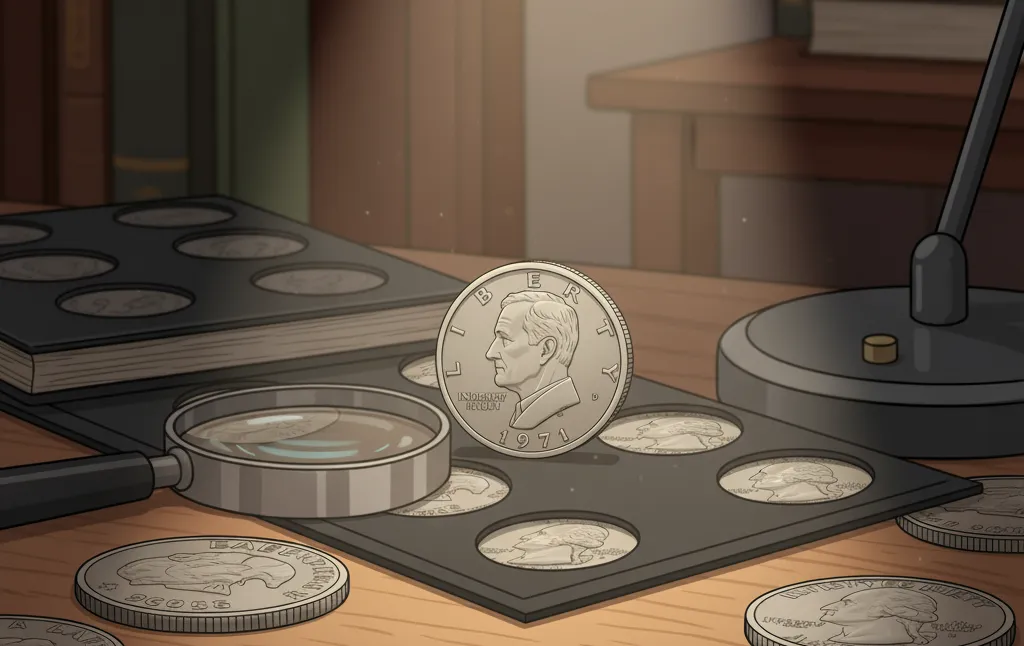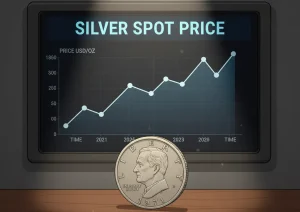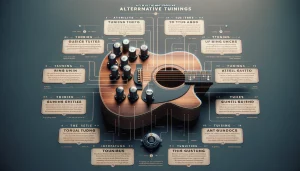In addition to aesthetics and history, many numismatists buy back silver coins, for example, the 1971 silver dollar, and in terms of investment.
They are interested in the amount of precious metal inside the token, but this is not the most stable investment.
Buying gold in any form is something stable, since the value of gold does not jump every day, while the price of silver changes too quickly, so you need to approach the matter wisely.
You can buy silver coins for a change, or as a manifestation of numismatic interest, but it is important to understand all the subtleties.

| Name and Variation | Approximate Value |
| Morgan Dollar | |
| Morgan Dollar (P, D, S, O Mint) | $30 – $50,000 |
| Morgan Dollar (CC Mint Mark) | $150 – $500,000 |
| Morgan Dollar Proof (P Mint) | $1,000 – $75,000 |
| Morgan Dollar DDO (Double Die Obverse Error) | $100 – $5,000+ |
| Morgan Dollar RPM (Repunched Mint Mark) | $50 – $500 |
| Morgan Dollar Planchet Clipped (Error) | $150 – $1,500 |
| Morgan Dollar Struck Thru (Error) | $200 – $1,000 |
| Peace Dollar | |
| Peace Dollar (P, D, S Mint) | $35 – $3,000 |
| Peace Dollar 1921 High Relief | $250 – $10,000 (depending on grade) |
| Peace Dollar Off Center (Error) | $300 – $3,000 (high-grade examples) |
| Eisenhower Dollar (1971–1976) | |
| Ike Dollar (1971-S 40% Silver) | $15 – $6,900 (Uncirculated to Gem Grade) |
| Ike Dollar (1971-S 40% Silver Proof) | $25 – $13,800 (Proof to Deep Cameo) |
| Ike Dollar DDO / RPM Errors (Non-Silver) | $50 – $500 (depending on grade) |
Values change based on market demand, condition, grading, and the specific characteristics of individual coins.
The Morgan Silver Dollar (1878–1921)
The Morgan Silver Dollar, designed by George T. Morgan, was made from 1878–1904, and then again for one final year in 1921.
Design Features
- Obverse: Features an image of Lady Liberty with a crown of wheat and cotton.
- Reverse: An American Eagle with its wings spread wide, holding arrows and an olive branch, symbolizing war and peace.
Mint Locations
- Philadelphia (P): No mint mark is typically used
- New Orleans (O): Used the “O” mark
- San Francisco (S): Used the “S” mark
- Denver (D): Used only in 1921
Standard Specifications
- Total Weight: 26.73 grams
- Diameter: 38.1 millimeters
- Composition: 90% silver, 10% copper
- Actual Silver Weight (ASW): 24.06 grams of pure silver.
- Mintage: from about 300,000 to over 10 million
Auction Record Note: A very rare and famous 1893-S Morgan Silver Dollar was sold for approximately $735,000 at a Stack’s Bowers Galleries auction in 2021.
Market Value Table
| Grade | Approximate Value |
| Circulated (Good/Fine) | $30 |
| Uncirculated (MS-60) | $45 |
| Gem Uncirculated (MS-65) | $150 |
| Key Dates (e.g., 1893-S, MS-60) | $10,000+ |
The Peace Silver Dollar (1921–1935)
The Peace Silver Dollar was first made in 1921 and continued until 1935. It was created to celebrate the peace that followed the end of World War I.
Design Features
- Obverse: A young Lady Liberty wearing a crown of light rays
- Reverse: A bald eagle standing on a mountain with a large sun rising in the background, holding an olive branch
Standard Specifications
- Total Weight: 26.73 grams
- Diameter: 38.1 millimeters
- Composition: 90% silver, 10% copper
- Actual Silver Weight (ASW): 24.06 grams of pure silver
- Mintage: from about 360,000 to over 51 million
Auction Record Note: A very high-quality 1921 Peace Dollar with the high-relief design sold for approximately $132,000 at a Heritage Auctions event in 2020.
Market Value Table
| Grade | Approximate Value |
| Circulated (Good/Fine) | $35 |
| Uncirculated (MS-60) | $60 |
| Gem Uncirculated (MS-65) | $250 |
| Key Date (1921 High Relief, MS-60) | $5,000+ |
The Eisenhower Silver Dollar (1971–1978)
The Eisenhower Dollar began in 1971 to honor President Dwight D. Eisenhower and to celebrate the first Moon landing.
Collector Issue Specifications
- Total Weight: 24.59 grams
- Diameter: 38.1 millimeters
- Composition: 40% silver, 60% copper/nickel (silver-clad)
- Actual Silver Weight (ASW): 9.84 grams of pure silver
- Mintage (Regular Strike Silver): 6,868,530 pieces
- Mintage (Proof Silver): 4,265,234 pieces
Auction Record Note: A very highly graded 1971-S Silver Eisenhower Dollar (MS-68) sold for approximately $6,900 at a Heritage Auctions event in 2012.
Market Value Table
| Grade | Approximate Value |
| Uncirculated (MS-60) | $15 |
| Gem Uncirculated (MS-65) | $35 |
| Proof (PR-65) | $25 |
| Best Known (MS-68) | $6,000+ |
Understanding Valuable Coin Errors and Varieties
- Double Die Obverse (DDO): The front design is pressed twice, causing letters or numbers to look doubled or split
- Repunched Mint Mark (RPM): The small mint location letter like ‘D’ or ‘S’ was hit more than once or struck in a different place.
- Planchet Clip: A piece of the metal blank was cut off before stamping, leaving a smooth, missing section on the edge.
- Off-Center Strike: The coin blank was not in the correct position when struck, causing the design to be only partially stamped, often leaving blank space.
- Struck Thru: A piece of foreign material like dust or string falls onto the blank and gets impressed into the coin surface during striking.
- Thickness Stock Error: The coin was made on a blank that was slightly too thick or too thin, resulting in a coin that weighs more or less than the standard 26.73 grams or 24.59 grams for Ike Silver.

Actual Silver Weight
The ASW is the exact amount of pure silver metal inside any coin, setting the minimum value of the coin based on the current market price of silver.
- Morgan and Peace Silver Dollars (90% Silver): Each coin contains 24.06 grams of pure silver.
- Eisenhower Silver Dollars (40% Silver): Each collector-issue coin contains 9.84 grams of pure silver.
The price of silver on the world metal market changes every day, and as that price goes up or down, the ASW or melt value also changes, but the collector value is based on rarity and condition.
Tips for Selling Your Silver Dollars
Preparation and Appraisals
- Organize: Create an inventory list noting the date, mint mark (P, O, S, CC, D), and your perceived condition for each coin.
- Get Multiple Offers: Never accept the first offer — negotiate with several reputable local or online dealers, knowing the wholesale price range will prevent you from accepting a lowball offer.
- Know Your Melt Value: If a coin is common or heavily circulated, its value may only be slightly above its ASW — you should be sure to calculate the value before selling, especially to bullion dealers.
The Importance of Professional Grading
For any coin that appears to be Uncirculated (MS-60 or higher), or if it is rare like the 1893-S Morgan, you should consider professional grading.
- Services: The two most recognized and trusted third-party grading services are PCGS and NGC.
- Value: A professionally graded coin, especially one slabbed as MS-65 or higher, increases buyer confidence and liquidity.
- Cost vs Value: Do not submit low-value, common, or heavily circulated coins for grading, as the grading fee will likely be more than the value.
| Venue | Best For | Pros | Cons |
| Local Coin Dealer | Common coins, smaller collections, quick cash | Fast, easy, immediate payment, no shipping risk | Dealers must make a profit, so offers are below full retail value |
| Major Auction House | Extremely rare, key date, or high-value collections | Highest potential final selling price due to bidding wars | High commission fees (12–20% or more), long wait time (weeks/months) for payment |
| Online Marketplaces (eBay, Forums) | Mid-range collectible coins, or selling to specialized collectors | Access to a wide audience, potential to achieve closer to retail price | High seller fees, responsible for shipping/insurance, risk of buyer fraud/disputes |
| Bullion Dealer | Heavily damaged, cleaned, or non-collectible coins | Fast sale based purely on metal content | You only receive the melt value, ignoring any numismatic value |






